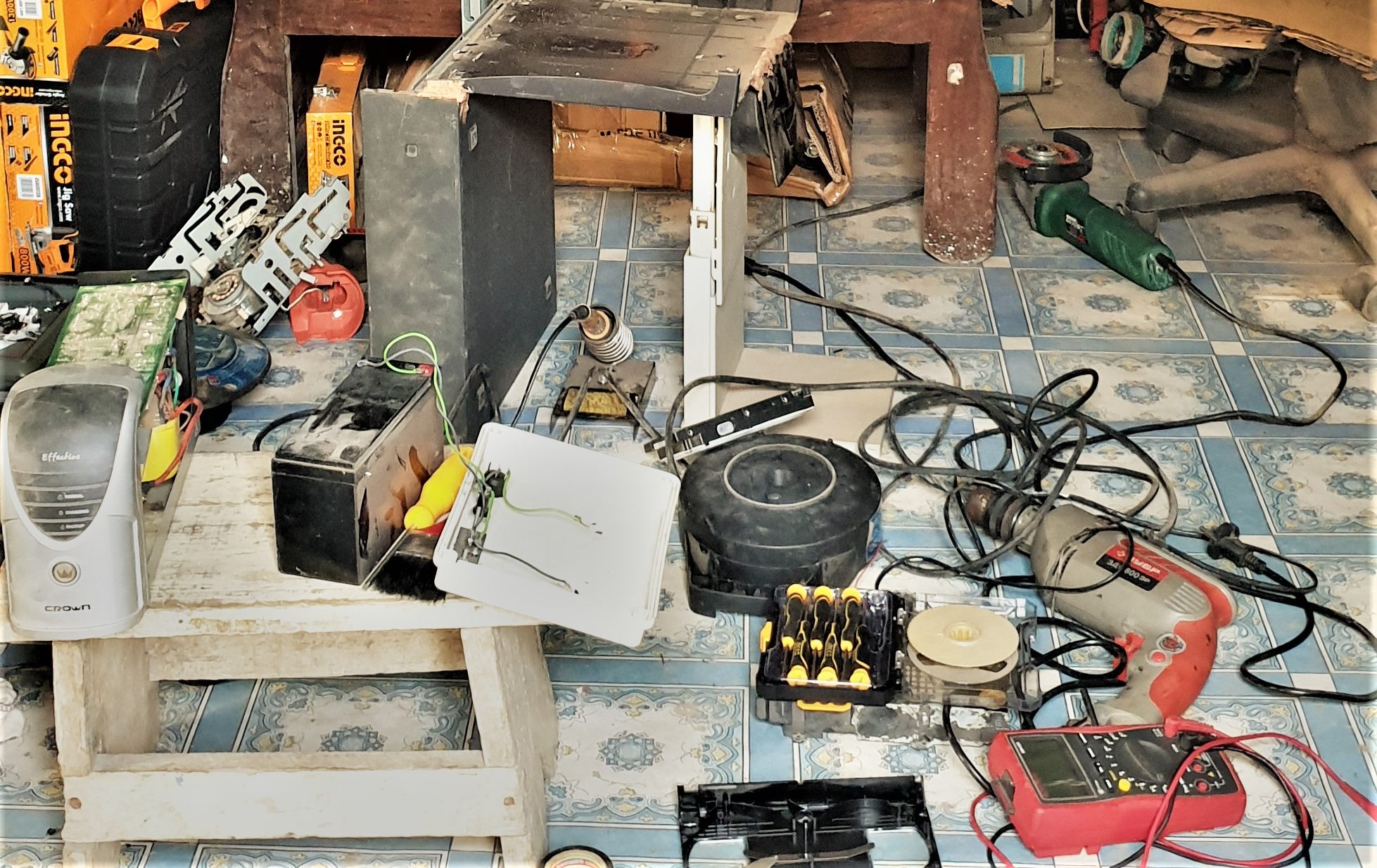ELECTRONIC GIZMOS THROUGH NETWORKS OF DESIRE, MINING AND WASTE

Akwasi Bediako Afrane collecting electronic waste materials from a second hand dealer for his installation
In conversation with Akwasi Bediako Afrane, we discussed the circulation of electronic devices, their environmental impact and how he is tracing relationships between humans and machines through his TRONS.
Mobile phones, telephones, televisions, computer sets, laptops, PDAs, VCD/CD/DVD players, radio receivers and amplifiers are some of the electronic gadgets artist Akwasi Bediako Afrane collects to build his machine hybrids, called ‘TRONS’. Afrane is interested in our relationships with electronic objects and how we share our daily rhythms with them. This includes the increasingly faster cycles of desiring and discarding those devices, as well as the environmental impact that implies. Through his installations, he uses electronic waste materials to build machines that question augmentation and prosthesis between visitor and machine. “I work primarily with discarded electronic gadgets,” states Afrane, “which are practically working electronic devices that have been ditched by their owners in search for a newer or an updated model.”
Based in Kumasi (Ghana, West Africa), he receives most of his materials through local second hand dealers. “Agbogbloshie“ is the nickname of Ghana’s most extensive e-waste desert, where so-called “Kon’dem” search through the wasteland to collect valuable parts to resell. He prefers gadgets that are situated within the home, as those are electronic devices that touch our lives most intimately. Afrane describes how “through these relationships, we leave traces of shared histories when we discard these gizmos.” Personal histories of time spent with a certain object intersect with histories of those devices moving through a global system of mining, production, advertising, usage, and waste. Afrane uses e-waste materials as an entry point to interrogate those shared histories.

Archive of electronic devices in Afrane’s studio
Over the course of this year, he is building what he calls “a giant TRON, that will seek to amplify the initial concept of white-boxing into a quintessential level of experience.” The “giant” will be showcased at the conclusion of Driving the Human, in November 2022. In addition to this installation, he is extending his research around electronic materials, focussing on the mining and re-usage of their mineral components within West African mines. Ghana is an essential exporter of Manganese and Kongo is of Cobalt, minerals which are used for manufacturing lithium-ion batteries used in portable electronic devices. Their mining also impacts land-use change and sets off a sequence of associated environmental impacts like deforestation, erosion, noise, and emissions. Digital worlds are mined and transmitted via earth minerals, which return to those landscapes transforming them into electronic wasteland. “I plan on creating a documentary elaborating on the continuous life of some natural minerals,” states Afrane, “which are chiefly used for the creation of some of these electronic devices.” Through this documentary he aims to contextualise the materials of his TRONS, as well as outlining a cycle of environmental damage caused by the scale of consumer interest and industrial production.

Work in progress images from Afrane’s studio
Afrane is using electronic devices as materials to discuss the many physical and emotional traces our digital worlds leave on our inner and outer landscapes. He underlines “the necessity to bring people to a state of openness in terms of understanding and interpretation of urgent issues.” Through constructing machines that we haven’t experienced in that exact way, but which still echo the many devices we left behind, he asks us to examine how we relate to those machines: How do we assign value? How do we develop desires to purchase and discard? Through his TRONS he is offering physical interactions that experiment with new ways of relating to our electronic devices. Afrane is aiming to “to create projects that do not propose a solution, but rather projects that have the ability to incite discussions, and consent to varied elucidations from diverse perceptions.”
Text by Aisha Altenhofen / Images by Akwasi Bediako Afrane








